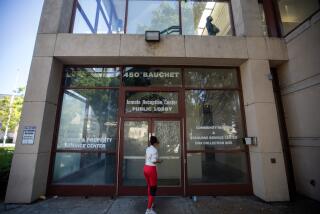Gas Sickens 10 at Electronics Firm : Nearby Solar Business Source of Toxic Leak in Chatsworth
Ten people were treated for nausea and respiratory irritation Thursday after toxic gas seeped from a Chatsworth research laboratory and was sucked into an adjacent building through its ventilation system, officials said.
The chemical, hydrogen selenide, escaped from Arco Solar Inc., 20554 Plummer St., about 7:45 a.m. when a scientist opened a cylinder believed to have been emptied of the colorless, pungent gas, said Arco Vice President Charles F. Gay.
A chemical sensor immediately detected the gas and the researcher closed the stainless-steel cylinder, but not before the gas got out, Gay said.
The gas can be smelled in concentrations as small as 0.3 parts per million. It was carried by the wind toward a neighboring firm, Integrated Electronics Corp., where it was drawn into an air intake. Workers there became nauseated and dizzy and fled the building. Some also complained of burning eyes and sore throats.
At high concentrations, which authorities said were not reached during the spill, the chemical can cause lung and liver damage.
The injured were taken to two Canoga Park hospitals--West Park Hospital and Humana Hospital-West Hills--where they were under observation for several hours and then released.
No one at the Arco laboratory was injured. The building was evacuated for about 45 minutes. Employees were kept out of Integrated Electronics for about three hours while the building was ventilated.
An official of the Los Angeles County hazardous-waste control program was investigating the leak. Arco said it was also conducting its own investigation.
Researchers at the Chatsworth laboratory use hydrogen selenide as part of a coating operation in constructing photovoltaic cells, Gay said. The cells convert solar energy into electrical energy and are collected in solar panels being developed at the laboratory.
Gay speculated that, despite an overnight attempt to flush gas from the cylinder, trace amounts may have clung to the container’s surface and escaped when the scientist broke the seal.
Gay said the equipment processing hydrogen selenide would be idled pending the conclusion of Arco’s investigation, although he doubted that any equipment or safety procedures had failed.
An inspector from the Air Quality Management Board will be asked to study Arco’s hydrogen selenide filtration system and perhaps recommend the installation of a backup filter that would trap dangerous chemicals should they escape into the atmosphere, said William Jones, a county hazardous-waste investigator.
Fire crews did not immediately enter either building because of the high toxicity of the gas. “We certainly don’t go in when it’s something as hazardous as hydrogen selenide,” Battalion Chief Frank Motheral said.
Instead, firefighters waited for a Fire Department hazardous-materials team to enter Integrated Electronics and test for concentrations of the chemical. The readings indicated that the gas had dispersed.
More to Read
Sign up for Essential California
The most important California stories and recommendations in your inbox every morning.
You may occasionally receive promotional content from the Los Angeles Times.










